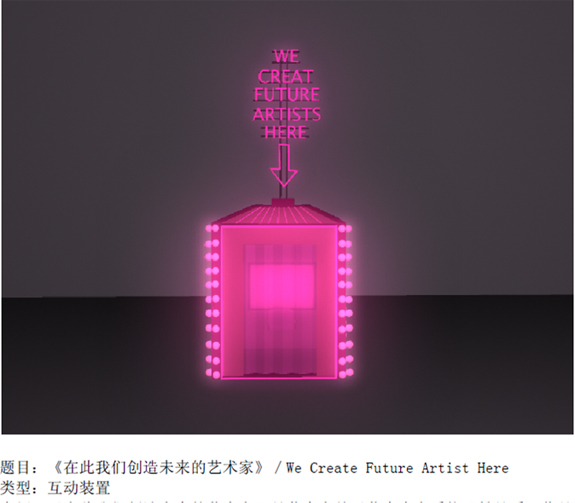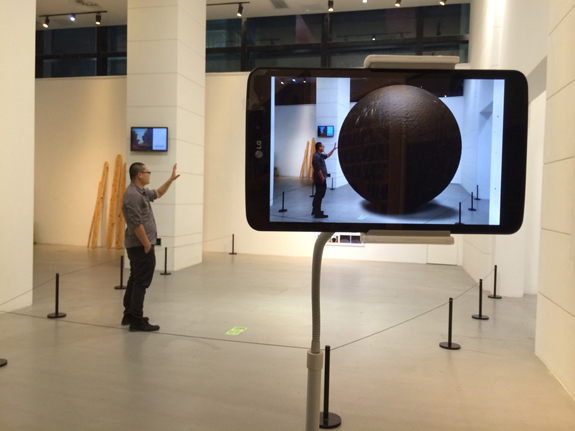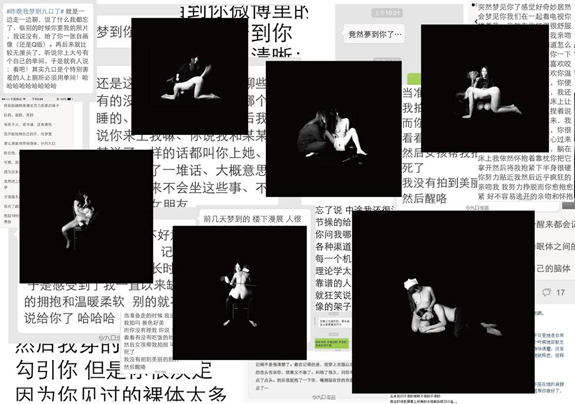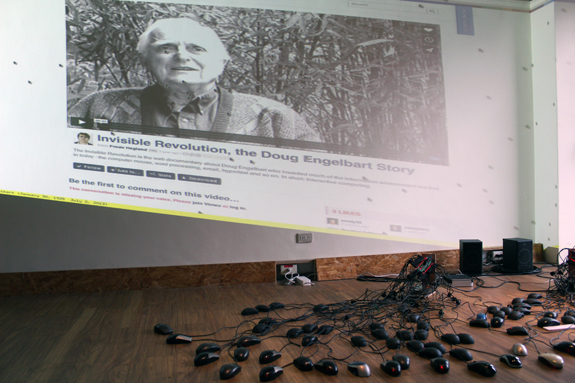
“第二届CAFAM未来展”以通过各种方式实现创意的“创客”为宏观主题,分“共智场”、“源代码”、“云生产”、“E循环”以及“未来方程式”五个单元,以知识和现象的共识、新型媒介和工具的实现为线索,调查青年艺术的生存现状与生态。无疑,这是一次艺术的当代属性尤为明显的展览。此次展览所呈现的当代性已然超越了社会和政治的批判,体现为对现实环境的拷问和艺术本体语言的无限拓展。虽然展览的五个单元尽量概括了作品的共性特征,但“不确定性”仍然是展览的一个总体标签,不仅表现为艺术家的未来及其作品不容定性,批评与阐释的空间和维度亦难以释放。有感于此,笔者无意过多解读参展的具体作品,而试图站在一个宏观角度,对这个展览涉及的三个问题进行杂谈,即当艺术遭遇当代文化,它的边界消失了吗?当代文化赋予艺术家令人目眩的媒介和手段时,艺术的内容就不重要了吗?面对这种不确定的青年艺术,批评的效力何在?
图1 王欣/在此我们创造未来的艺术家/互动装置/尺寸可变/2014
艺术创作的主体是一个社会化的自然人,人的社会化过程也是社会文化内化的过程。社会文化的建构和侵袭使人成为一个遵守特定行为规范的社会人。本质上讲,我们都是社会人,但不同时期的人对社会文化建构的反应大为不同。在商品、信息、科技文化日新月异的当下,青年一代的接受能力和反应速度,放在几十年前的人们身上根本无法想象。生活在一个充满多渠道高速信息流的世界中意味着什么?这是青年一代面临和必须思考的问题。如今,“漫画卡通一代”似乎已成为了过去时,而全新的“数码一代”正在崛起。信息的通达和技术媒介的便利使得青年一代的艺术家易于获取和接受当下的高速信息流和媒介语言,极大影响了当代艺术的生产。于是,我们在“第二届CAFAM未来展”中看到了数码视频的制作与剪辑、全息摄影技术、光艺术和交互式电脑网站等非传统性因素的大量涌现,胡为一《低级景观》、李天伦《发展中的音域》、张增增《无形之形》和郑先喻《肖像2013》皆是此类。“工具理性”或许正在占领当代艺术这块高地,成为当代艺术的外在表征。
既然在当代艺术中,信息的拓展和技术的突破为艺术探索开辟了新的战场。那么,这就不可避免地会涉及到一个问题,即艺术的边界消失了吗?这必定是个老生常谈的话题,但也必定在每个时代都有其存在的合理性。过去数百年来艺术反复出现的一个主题就是艺术领域和其他文化分类之间的区隔日渐模糊。如果说艺术与文学、戏剧和大众文化等类型的交叉共生早已发生和定型的话,那么如今,当代艺术与当代文化生活的交织及两者之间界限的消解正朝多个方向延续。甚至,稍显激进的观点认为,当代艺术就是当代的视觉文化,当代艺术家将非艺术经验带入艺术领域,同时也把艺术引进大规模的视觉文化中去,创出潜在异类元素的块茎综合体,譬如吴其育《打折》的代购消费经验以及肖般若的植物生长经验等。通过故意让作品的展示机会不仅仅局限于展览的场地及作品本身,而将作品和其他视觉文化产品予以混搭,侧重探索艺术的当代属性的艺术家“一直在找寻一种近似于周边策略的方法,将重点放在如何见缝插针地将其创作计划置于过度媒体化的公共领域的无序状态中去”[1]。
图2 张增增/无形之形/互动装置/尺寸可变(与妙果数码联合制作)/2014
当代艺术看似一个悖论,是艺术,也是反艺术,然而悖论的生发实乃源于“艺术”概念的模糊与混淆。此次CAFAM未来展的经验再次告诫保守的世人:我们针对艺术的观念早该转变了,因为在当代,艺术的边界、范围、媒介、思想、功能乃至性质都已得到巨量的拓展。犹记得展览开幕之后,各路媒体的报道充斥着“踏踏实实画画的作品基本不见”一类的话语,可见我们对艺术尤其是当代艺术的性质的认知仍旧模糊。实际上,“艺术”乃是文艺复兴时期的概念,囊括绘画、雕塑和建筑等门类,这个概念的使用一直到哲学家阿瑟·丹托那里才走向终结。按照丹托的说法,从文艺复兴到20世纪中叶,人类讲述的是一个有关艺术的故事,但自现成的物成为创作的主流媒介以来,这个艺术的故事就终结了。然而,故事并非就此终止,而是继续演绎,只不过讲述的已不再是艺术的故事,而是非艺术的故事,或是另一种艺术的故事。唐纳德·贾德在《特殊的物》中谈及自己20世纪60年代的方体结构的系列作品时明言,这种作品既非绘画,也非雕塑。那么,他的作品也就脱离了艺术的故事,而进入了另一种艺术的叙事,也就是当代艺术。[2]当然,贾德的作品仅仅处在现代艺术与当代艺术的衔接阶段,只有进入到了信息和技术高度发达的当下文化,当代艺术的鲜活生命力才得到了无以复加地彰显,艺术的边界和范畴似乎彻底消失了,作品可以采用任何媒介、从多样性视角(包括流行文化、科学、宗教、历史、政治和性)来表征现实,它们需要新形式的视觉知识水平,要求观众跨越类别和主题之间的边界完成信仰的飞跃。
繁荣的当代商品、技术和信息文化为艺术的实现提供了媒介和手段的无限可能,造就了景观的庞大累积,这在某种程度上是否会降低艺术内容的重要性?“第二届CAFAM未来展”带给笔者的最大直观感受即是这个问题,毕竟展览的策划方以“创客”为宏观主题,下划“共智场”、“源代码”、“云生产”、“E循环”和“未来方程式”五个单元,似乎主要以作品的形式创新方式作为归纳划分作品的基本线索,而在这条线索的荫蔽之下,作品内容的意义貌似被刻意隐藏了。但是,细心观览作品之后,笔者发现,形式和手段的创新只是青年艺术现实表征的外在形态而已,展出的作品仍然延续了当代艺术一贯为之的内容,依旧归于身体、身份、时间、科学、场所和语言等主题形态。因此,纵然形式、媒介乃至意义如何拓展与开放,内容仍然至关重要,这是笔者抛开展览本身形式的表面浮华之后的最大观展体会。以下便从“两种身体的共生”视角归纳和阐释展览作品的其中一个主题内容,即身体。
图3 九口走召/昨晚我梦见九口了/摄影/尺寸可变/2014
当代艺术家聚焦于身体主题是对艺术生产所持的激进主义立场的结果,在这种立场的主导之下,个人经验变得极富政治性,身体也由此成为观念承载和意义生发的场所。文化的、性别的、种族的、社会的差异成为了当代艺术中身体艺术的惯常表现形态,这从中国和西方近三十年来的当代艺术发展史中即可得见。然而,从这届CAFAM未来展的内容呈现来看,身体艺术表现出了两个新特点,其一是艺术家不再追求身体的政治性表达,而是立足于身体的微观感受,身体不再是蕴含某种诉求的武器,艺术家只是用身体来体验世界,身体的感官系统使他们获得关于世界的知识。此外,身体也不再作为一种感性媒介被直观使用,而是存在于艺术家作品的隐性空间之中。除了九口走召《昨晚我梦见九口了》和陈天灼《“19:53”预告片》直接利用身体图像之外,其他涉及身体主题的作品都只是对身体感受的隐性表达,譬如在何翔宇的《坦克计划》中,身体软性器官组织与景观世界的符号生产的对接便是如此。或许是青年一代艺术家的直观身体感受变得更为敏感,或许是他们的社会阅历和人生经验尚不足够,总之,他们的身体艺术既不反映社会,亦不批判社会,而是新的时代环境下的新的生存论。这与以往当代艺术中的身体主题形成了强烈反差。
另外一个新特点是身体的意象体现了一种由外到内、由表到里、由明晰到隐喻的转向。或许我们在此次展览中很少看到与身体图像直接相关的作品,但身体仍然是这次展览的一大主题内容,只不过这里的身体已然不再是作为主体的艺术家呈现的身体,而是观者的具身的身体,观者作为一种身体-主体强势介入了作品意义的生成当中。这是一种梅洛·庞蒂现象学视域下的隐而不现的隐喻身体,其中,身体并非作为一种直观的形象显现,而是艺术家心中预设的构成作品意义的能动对象。按照这种身体现象学的解释,一旦观者步入作品所在的空间,他们就好像进入了艺术家精心设计的迷宫,不仅会产生时间的绵延,还会导致观者的身体知觉与作品的空间互动,及其带来的作品意义的无限外延。在这个过程中,观者经历了一场现象学的观看,通过具身的方式,融合身体意识和精神知觉,艺术家不再作为主体,他们的艺术经历已然优势不再。
图4 陈天灼/“19:53”预告片/影像装置/尺寸可变/2014
肖般若的《生长移植计划》、王欣的《在此我们创造未来的艺术家》、毕蓉蓉的《7:3 Colors》、王恩来的《空洞》,以及郑先喻的《肖像2013》等作品皆属此类。以肖般若为例,虽然其作品意图探讨自然力与人力的关系,但实则是对观者的身体意识和精神知觉的开发过程。观者一旦步入作品所在的空间,入目所见的是两盆植株和三张照片,以及众多装有植物的手提袋,但事物的意义恰恰不在于它们看起来是什么,这种通过单一视角获得的知识往往具有欺骗性。艺术家希望观者以他们的身体作为知觉的容器,对作品进行时间和空间的绵延感知。因此,观者必须进入作品所在的空间并漫步其中,最终带走一袋植株,从而完成作品空间的拓展和意义的外延。所以,在对《生长移植计划》这类典型的当代艺术的解读中,我们必须在“事物看起来是什么”和“事物被认为是什么”之间做出明确的区分,前者是我们对于事物的视知觉,而后者是由作品的内在与外在部分定义的三维乃至四维结构。
简单而言,当代艺术的一个主流现象是艺术家在某种程度上将作品意义的生产权和解释权交给了观者。凭借身体的感知,而非视觉的智力,观者对作品的具身融入完成了意义的推倒和重建。在这个过程中,观者是具身的主体,具有动态视觉的自我,通过运动的方式获得知识。这种强调作品与观者的现象互动的当代作品或许在西方早已不是什么新鲜事,但在中国却正在成长为当代艺术创作的一个主导趋向。作为调查青年艺术生态的一份显性报告,“第二届CAFAM未来展”做出了明确的例示,部分作品更是印证了这个潮流,说明青年一代艺术家作品的思考方向。因此,无论展览本身的结构和策展的意图如何刻意引导观者去关注和留意艺术与当代文化在形式和媒介方面的浪漫邂逅,这些都不能掩盖内容和主题的一贯延续和微妙演化。所以,内容仍然至关重要!
图5 肖般若/生长移植计划 2013-2014/综合材料/尺寸可变/2013-2014

图6 郑先喻/肖像 2013/互动装置/尺寸可变/2013
既然“第二届CAFAM未来展”是一次面向青年艺术的未来的展览,那么,它势必在一个时段之内具有风向标的作用。若此,青年艺术的未来即将走向何方,很大程度上有赖于批评的无意识和无目的的推动,虽然批评对当代艺术很难做出结论,毕竟存在太多不甚确定的因素。那么,批评如何推动和引导,从而对当代青年艺术的发展起到隐性的作用?在这里存在一个问题,即当代艺术的批评与研究具有一个逻辑化的问题,即我们往往谈论的是批评语言本身的逻辑,它自成一个体系,而不是将重心放在艺术本体的产生、发展及其产生的结果上面。批评的效力有时会推动艺术朝着另一个方向发展,虽然仍然处在批评的逻辑当中。鉴于此,批评效力的发挥一定程度上取决于批评的方法是否合适,新的方法往往能够达成出其不意的效果,从而在无意识中推动艺术的方向转变与推陈出新。
我们可以在历史中找到类似的参考和借鉴。20世纪60年代,迈克尔·弗雷德以源自现代主义辩证逻辑的“物性”(实在主义)和由此衍生的“剧场性”概念介入极少主义的批评,从而打开了后现代主义艺术的大门,随后的观念、装置乃至新媒体艺术在本质上都处于弗雷德的“剧场性”批评模式的范畴之内。而针对极少主义的批评,正是采取了现象学的方法,摒弃了主流的形式主义分析,现代艺术的发展脚步才会中止,当代艺术的曙光正式降临。具体而言,极少主义现在被众多艺术批评家,比如哈尔·福斯特、罗莎琳·克劳斯乃至晚年的迈克尔·弗雷德等人,公认为是现代主义与后现代主义,或者现代艺术与后现代艺术的分水岭。在极少主义生发的20世纪60年代,他们可能还没有这种判断的意识,也无法预测极少主义之后艺术的走向,但半个世纪之后,作为历史的拐点角色出现的极少主义已然成了一种定论。但是,这种定论内含的深意在于,并非极少主义艺术本体较之以往的现代艺术做出了多么重大的后现代突破,确立这种转变的基调和后续发展态势的乃是新式批评的浮现与主导。在某种程度上,当代艺术与批评休戚与共,批评的力量甚至引导了当代艺术的走向,它可以终结一个艺术时代,同时也可以新生另一个艺术时代。
中国当代艺术批评经过了将近30年的发展,似乎衍生了一种体制化的惯性思维和后继不力的疲乏状态。相比较于青年艺术的蓬勃态势,青年一代的批评作为一个整体呈现出了相对滞后的局面。面对新生的青年一代艺术,能够引导青年艺术走向的批评的方向和方法何在?艺术批评的效力如何释放?这些问题值得我们关注。这是一个批评的时代,批评的力量理应得到高度重视,只是应该坚持两个原则,一是当代艺术批评不应存在目的和结果的预设,二是当代艺术批评需要侧重于自身的逻辑建设。因此,归根结底,青年艺术的未来在于青年艺术家自身的发展以及针对青年艺术的批评,而专注于展示青年艺术生态的CAFAM未来展无疑为我们提供了这样一个批评的空间。
中央美术学院人文学院在读博士
朱橙/文
